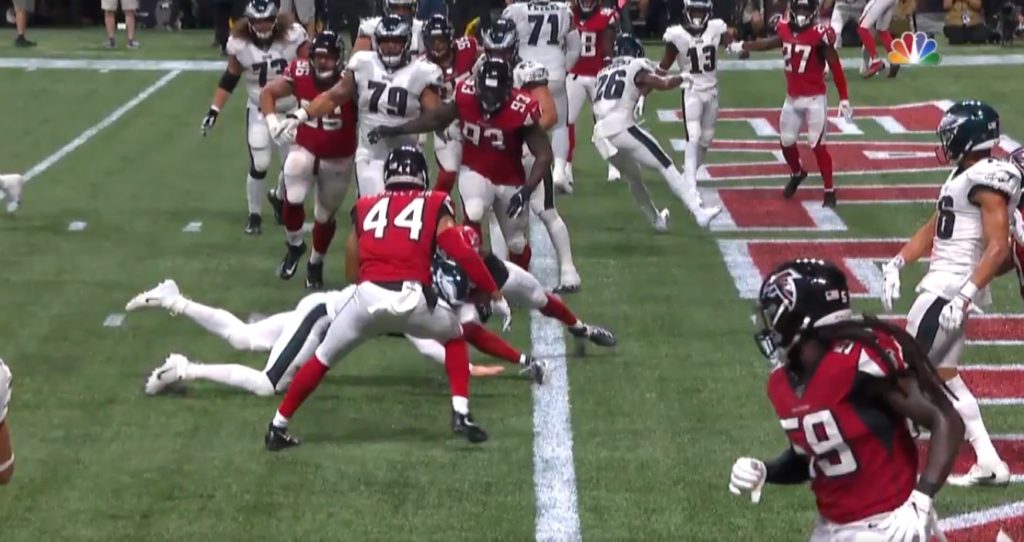Ad Disclosure
NFL Officials Are Giving Us Explanations That Don’t Make Sense

Let’s take it back to September 16th, the Atlanta Falcons game.
Remember the two-point conversion that took place in the third quarter? It was the Carson Wentz run that was initially ruled a success, then reviewed and reversed.
Why was it reversed? Because of some quirky explanation telling us that Wentz had given himself up and was ruled down before reaching the goal line.
After the game, the NFL put out this video with Vice President of Officiating Al Riveron, who narrated through the play:
In #PHIvsATL, Philadelphia QB Carson Wentz was ruled short of the goal line, here’s why: pic.twitter.com/6XsrJzOEwr
— NFL Officiating (@NFLOfficiating) September 16, 2019
Riveron, in part:
“The ruling on the field is that he is successful. However, after review, the quarterback dives, gives himself up, and prior to crossing the goal line, his knee touches the ground. Therefore, by rule, the two-point conversion is not successful.”
Alright.
So let’s apply that to the play we saw on Sunday night, the late hit on Wentz from Jadeveon Clowney and the explanation following the game from referee Shawn Smith, via pool report:
“He was a runner and he did not give himself up. We saw incidental contact, and in our judgment, we didn’t rule that to be a foul.”
The first discrepancy is the matter of a quarterback “giving himself up.” Certainly Carson Wentz was not “giving himself up” when he was diving for a two-point conversion in the Atlanta game. The entire notion that a player would do that in an all-or-nothing goal line play defies logic. Either Wentz gets in or he doesn’t, so he would never surrender himself willingly.
But if we apply the same logic from Riveron’s explanation to what we got from Smith, then Clowney’s hit surely is late, if nothing else. Wentz’s knee is clearly down in the Seattle play, and he’s been contacted by safety Bradley McDougald, so is he diving and giving himself up? Or is the contact “incidental” because he got tripped up while trying to push forward for more yards?
The play:
Clowney using his helmet as a weapon. Hurts Wentz. No call. @NFLOfficiating this get missed. pic.twitter.com/MMCNwH6Peo
— Chris Babcock (@ChrisBabcock2) January 5, 2020
Regardless, the thing that can’t be argued is that Clowney is leading with his helmet. He’s clearly pointing the crown of his helmet downward, towards Wentz, and while there’s some elbow and forearm contact, he’s driving another player’s head into the ground. This type of hit, as others point out, would be reviewed for targeting in the college game, flagged, and probably resulted in an ejection.
So that’s one thing, the discrepancy over what constitutes a “runner” and “giving yourself up” when you’re a quarterback. The other thing is that the hit was illegal by definition of the new ‘leading with the helmet’ rule that was introduced last season.
And I do hear people asking about the Malcolm Jenkins Super Bowl hit on Brandin Cooks. If the Clowney hit is illegal, shouldn’t that hit have been illegal?
The answer is no, because the lowering the helmet rule didn’t exist back then. He could have been flagged for unnecessary roughness, but put enough shoulder into the contact that they decided not to whistle it. Plus, Jenkins hit a receiver and not a quarterback, and only one of those positions is protected in the contemporary NFL. That, I think, is the difference between those two plays.
Bottom line, we’ve got a consistency problem when it comes to NFL officiating and the explanations we’re given. Earlier this season, a diving Wentz was “giving himself up” at the goal line, which is in no way a logical ruling. Then, Sunday, we’re led to believe that “incidental contact” took place because he was a runner, yet he was doing essentially the same thing he did in the Atlanta game, unless the contact from McDougald is the difference, which was not specified in the pool report.
I dunno man. Your guess is as good as mine.
Kevin has been writing about Philadelphia sports since 2009. He spent seven years in the CBS 3 sports department and started with the Union during the team's 2010 inaugural season. He went to the academic powerhouses of Boyertown High School and West Virginia University. email - k.kinkead@sportradar.com